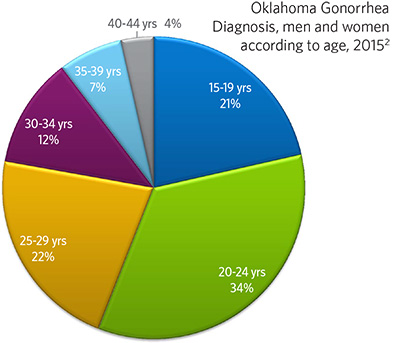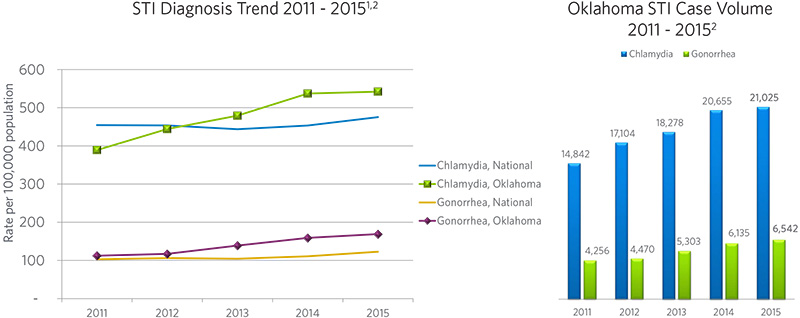Keep you and your partner healthy by learning about sexually transmitted infections

Chlamydia can cause serious, permanent damage to a woman’s reproductive system, making it difficult or impossible for her to get pregnant later on. It can also cause a potentially fatal ectopic pregnancy (a pregnancy that occurs outside the womb).5
How is chlamydia spread?
You can get chlamydia by having anal, vaginal, or oral sex with someone who has chlamydia.1,3,5
If you’ve had chlamydia and were treated in the past, you can still get infected again if you have unprotected sex with someone who has chlamydia.1,3,5
If you are pregnant, you can give chlamydia to your baby during childbirth.1,5

Gonorrhea can cause infections in the genitals, rectum, and throat. It is a very common infection, especially among young people ages 15-24 years.1,3,5
How is gonorrhea spread?
You can get gonorrhea by having anal, vaginal, or oral sex with someone who has gonorrhea. A pregnant woman with gonorrhea can give the infection to her baby during childbirth.1,3,5
Trichomonas vaginalis or “Trich” is an infection with a protozoan parasite that is easily spread from one person to another, usually through sexual contact and infects both women and men.1 This is a common and curable infection. Without treatment, the infection can last for months or even years.1
How is trich spread?
The parasite is passed from an infected person to an uninfected person during sex.1,5 In women, the most commonly infected part of the body is the lower genital tract (vulva, vagina, cervix, or urethra), and in men, the most commonly infected body part is the inside of the penis (urethra). 1,3,5
Infected people without symptoms can still pass the infection on to others.1,3,5
Diagnosis can be quick and easy with multiple specimen options
Have an honest and open talk with your health care provider and ask whether you should be tested for chlamydia, gonorrhea, trichomonas, or other sexually transmitted infections.
Chlamydia, gonorrhea and trich can be detected with a single swab or urine sample. You can also be screened for these infections by requesting that additional tests be done with your Pap smear. Check with your insurance company to see if these tests are covered under your plan.
Patients can be tested privately and securely for certain sexually transmitted infections (STIs) without a provider order through QuestHealth’s Sexually Transmitted Disease testing. Urine and blood specimens can be collected at any DLO Patient Service Center to detect chlamydia and gonorrhea, as well as other common STIs.
Order your own STD Tests through QuestHealth®
Chlamydia, gonorrhea and trich are easily treated and cured with common and affordable antibiotics. Unfortunately, many cases go undiagnosed since most are without symptoms.1,3,5
When left untreated, sexually transmitted infections can have serious consequences
Untreated STIs can lead to pelvic inflammatory disease (PID). PID can have harmful consequences to your health, including chronic pelvic pain and infertility.1,6
Undiagnosed infections can be passed on during childbirth and cause serious complications for your baby.1,5,6
If you are a sexually active woman younger than 25 years, or an older woman with risk factors such as new or multiple sex partners or have a sex partner who has a sexually transmitted infection, you should get tested every year.1,3,5,6
Why get tested for sexually transmitted infections?
- You are at risk for a sexually transmitted infection. The highest rates of infection are in sexually active young women under 25 years of age, any woman with new or multiple partners, or a woman whose partner who has been diagnosed with an STI.1
- Chlamydia was the most commonly reported STI in Oklahoma during 2015, with gonorrhea second.2
- Most chlamydia and gonorrhea infections have no symptoms. An infection can go unnoticed, which can cause consequences later on.1
- Almost 2 million new cases of chlamydia and gonorrhea were reported to the CDC in 2015. For a second year in a row, increases were seen in these nationally reported STI’s. Chlamydia increased by 6%, while gonorrhea increased 13%.1
- Trichomonas infects an estimated 3.7 million people in the United States each year. Approximately 30% of those infected develop symptoms, resulting in the majority of cases going untreated.1
- Young people (ages 15-24) account for half of all new STIs reported to the CDC in 2015, yet they represent just 25% of the sexually active population.1

The American Academy of Pediatrics (AAP) recommends annual testing for chlamydia and gonorrhea. The AAP calls out testing as part of routine screening for sexually active female adolescents and young adults younger than 25 years.3
Testing as a teen helps to establish a lifetime of healthy habits and protects future reproductive health. Testing helps ensure that you can have children—when you’re ready.3
In adolescence, the female cervix is still not fully developed, which makes it more vulnerable to infections.3
Condoms do not provide absolute protection from sexually transmitted infections (STIs) as they are hard to use consistently and correctly.1
Regular checkups are an important part of reproductive health
Multiple health organizations recommend screening for chlamydia and gonorrhea, including the American Academy of Family Physicians, U.S. Preventative Services Task Force, and Centers for Disease Control and Prevention.
The American Congress of Obstetrics and Gynecology (ACOG) and The American Academy of Pediatrics (AAP) recommend regular screening for chlamydia and gonorrhea for all women who are sexually active, beginning in early adolescence.3,5
These routine tests can be added to the other screenings which are usually done as part of a woman’s annual physical.
Routine screening for sexually transmitted infections (STIs) can help protect your reproductive health in a number of ways:1,3,5,6
- Screening can catch an infection early, even if there are no symptoms
- If you have an infection, screening ensures appropriate treatment
- Effective treatment can help avoid complications like Pelvic Inflammatory Disease (PID), which is a leading cause of infertility6
Good habits that start when you’re young can help keep you healthy—today and in the future.
Resources
- Centers for Disease Control and Prevention. Sexually Transmitted Disease Surveillance 2015. Atlanta: U.S. Department of Health and Human Services; 2016.
- Retrieved from https://www.ok.gov/health/Disease,_Prevention,_Preparedness/HIV_STD_Service/Fact_Sheets_-_OK_Data/
- Reuters Health Information STI Screening Advocated for Pediatric EDs. Marilynn Larkin. March 22, 2016. Retrieved from http://www.medscape.com/viewarticle/860595;
- Sexually Transmitted Diseases Diagnosed in Oklahoma, by County of Residence. 2015 Retrieved from https://www.ok.gov/health2/documents/Table%20-%20STDS%20by%20County%202015.pdf
- Chlamydia, Gonorrhea, and Syphilis, Frequently asked questions; Gynecological problems; FAQ071, December 2016. Retrieved from http://www.acog.org/Patients/FAQs/Chlamydia-Gonorrhea-and-Syphilis
- Pelvic Inflammatory Disease (PID), Frequently asked questions; Gynecological problems; FAQ077, September 2015. Retrieved from http://www.acog.org/Patients/FAQs/Pelvic-Inflammatory-Disease-PID
Diagnostic Laboratory of Oklahoma (DLO) strives to empower patients to take a more active role in their healthcare decisions through providing education on disease states and available diagnostic testing, as well as resources for additional information from medical organizations.







